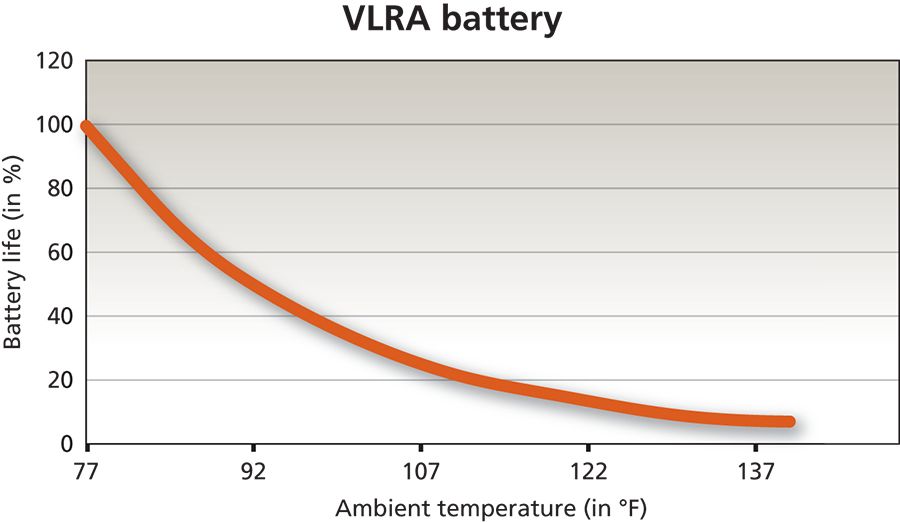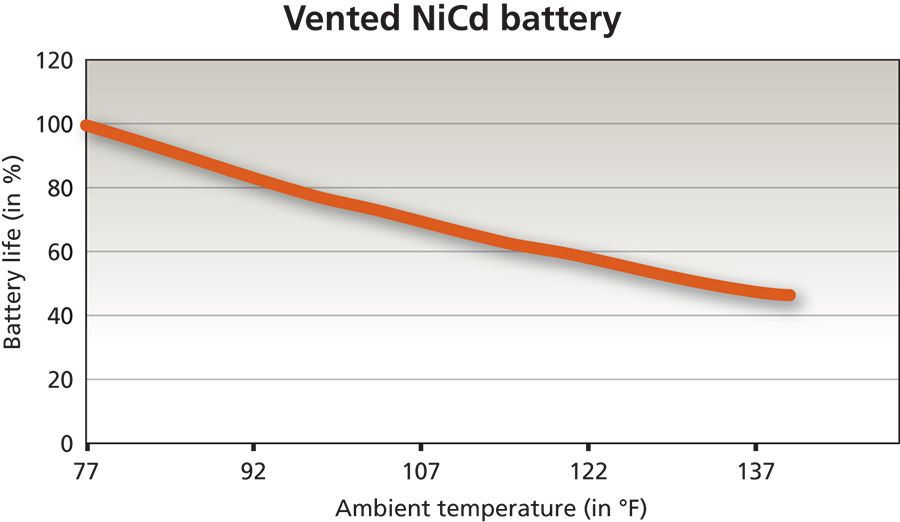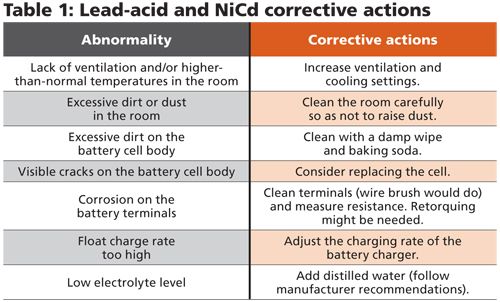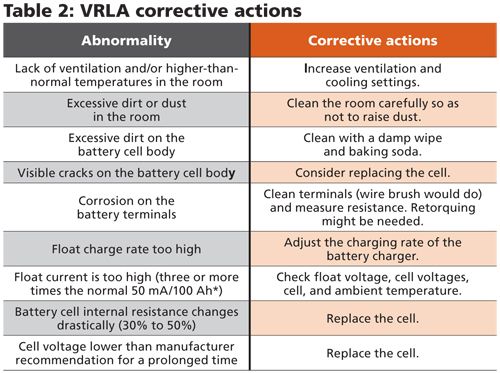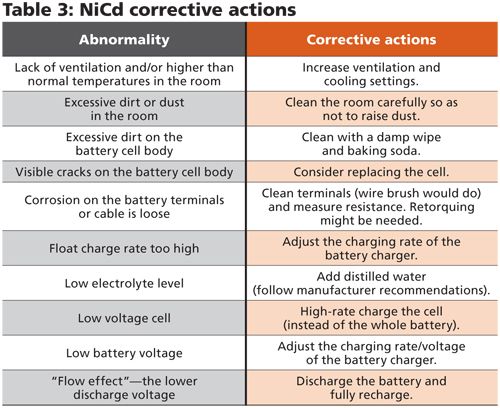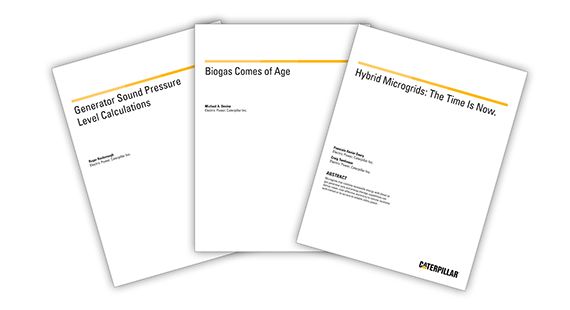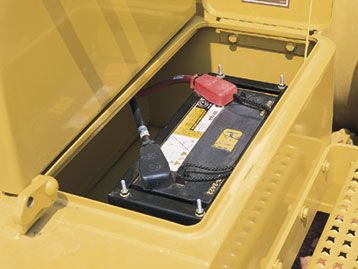Inspection
The maintenance of the batteries in mission critical facilities is especially important. When maintained regularly, batteries will perform according to design to support the critical systems, ensuring the continuance of power. Maintaining the batteries also elongates their life, resulting in lower operation costs. But the first step of maintenance is to inspect. By first inspecting and then assessing, we can develop a plan for remediation.
Let's look at each battery type separately. IEEE has developed separate standards for just this reason.
Vented Lead-acid: The most routine inspection for this type of battery is a visual inspection. IEEE has developed a standard, 450-2010, IEEE Recommended Practice for Maintenance, Testing, and Replacement of Vented Lead-Acid Batteries for Stationary Applications. This standard is a very good guide for the operations staff to create a maintenance procedure.
The monthly inspection, as recommended in the IEEE 450-2010 standard, includes the following:
A visual inspection of:
- The general condition of the area. The area (room) should be as clean as possible so that dirt or excessive dust does not cover the battery cells. Unclean equipment is harder to assess during a visual-only inspection.
- The battery cells for cracks. This step is important because a crack in the cell's outer shell could allow the electrolyte to leak and the battery to discharge.
- The electrolyte levels. A significant drop in the electrolyte level means that the specific gravity of the electrolyte has increased. A greater specific gravity would impact the life of the battery.
- The battery terminals for corrosion. Corrosion of the battery terminals will increase the resistance of the connection, thereby decreasing the amount of current supplied by the battery system.
A measurement of:
- The float voltage at the battery terminals. If the battery system performs at a float voltage outside the manufacturer's recommended range, the battery's life expectancy would be adversely affected.
- Room or area temperature and ventilation. The temperature is important because it impacts battery-life expectancy. Ventilation is important because proper movement of the air mitigates high concentrations of hydrogen, which is a byproduct of chemical processes in the battery cells. High concentrations of hydrogen in the air significantly increase the risk for explosions.
The IEEE 450-2010 recommendation for monthly visual inspection is just a general recommendation for any type of facility. NFPA 110 requires weekly visual inspections for battery systems employed in emergency and standby systems.
The recommended quarterly inspection includes the following:
A measurement of:
- The voltage of each cell. Lower-than-recommended (by the manufacturer) voltage levels could have an adverse affect on the life expectancy of the battery.
- The specific gravity of the cells' electrolyte. One needs to keep in mind that specific gravity of the electrolyte increases in a full charge. It would be best if three measurements are taken: one on top, one in the middle, and one on the bottom of the cell. The average of the three values is the value to be used. If taking three measurements is not possible, taking a reading as close to the middle as possible is best. Note that it's not necessary to measure the specific gravity of each cell in the battery string, rather only about 10% of the cells.
- The electrolyte temperature of a few cells. If we have a 125 V battery system, we'd have 60 cells. It would suffice to check the temperature of six of them. The desired temperature is the one recommended by the manufacturer. If the electrolyte is at a higher temperature, a higher float current is required to maintain the cell voltage. Too high of a charging current could adversely affect the electrolyte composition, as more of the hydrogen and oxygen is being gassed. On the other hand, the lower temperature causes a smaller floating current, which in turn, slows the charging process.
There is also a yearly inspection that applies the quarterly inspection to all the battery cells, which is, therefore, much more involved.
If abnormalities are observed during these inspections, there are corrective actions that can be taken.
The room temperature and ventilation usually are set during the design. Total cost of ownership analysis is usually done by taking into consideration the optimal conditions so that the battery life is longest. The rule-of-thumb correlation between ambient temperature and lead-acid battery life, be it vented or VRLA, is as follows: battery life decreases by 50% for every 15°F above the normal temperature, which is 77°F.
Battery Life
Determining the battery life is important, especially in mission critical facilities. With proper maintenance, battery life could be predicted accurately, thereby avoiding any downtime. The most important factors affecting battery life are:
Ambient temperature:
- Keeping the temperature at 77°F is optimal.
Maintenance:
- Keeping the cell temperature in check; large temperature differences among the cells (greater than 3°F) will affect battery life.
- Keeping the cell voltage in check. The following should be corrected:
- Voltage below open cell voltage + 0.06 V
- Voltage above open cell voltage + 0.1 V (or 0.05 V for lead antimony).
Cycling:
- The more discharges occur, the shorter the battery life.
Chemical components:
- Vented batteries can be lead-calcium, pure-lead, lead-selenium, or lead-antimony. All the outside factors affect the battery life differently, depending on the chemical composition of the battery.
VRLA Batteries
VRLA batteries currently are very popular. They are known as "nonmaintenance" batteries, mostly because of the fact that they are sealed and employ a "recombinant technology." The fact that the battery is sealed ensures the preserving of the electrolyte, no matter the position of the battery cell (you can even turn it upside down). Recombinant technology means that the oxygen released from the positive plate ends up in the negative plate, where it recombines with hydrogen and turns into water. This process preserves the battery water
Just as it has for vented batteries, IEEE has developed a standard, 1188-2005, IEEE Recommended Practice for Maintenance, Testing, and Replacement of VRLA Batteries for Stationary Applications.
Even though VRLA batteries are sealed, there are always dangers associated with installing and maintaining batteries. Only trained and knowledgeable personnel should work around batteries. In addition, unauthorized personnel should not have access to the batteries. The battery area should not be used as storage for tools or anything else. All personnel should use personal protective equipment, such as goggles, gloves, and safety shoes, while working on batteries
Just as with vented batteries, inspection is an important part of maintenance. IEEE recommends monthly, quarterly, and yearly inspections. But this recommendation is for general use. For mission critical facilities or processes, there needs to be a weekly inspection as well.
The monthly inspection for VRLA batteries is more or less the same as the one for vented lead-acid batteries. This inspection includes the following areas:
A visual inspection of:
- The general condition of the area. The area (room) should be maintained as clean as possible so that dirt or excessive dust does not cover the battery cells. Unclean equipment is harder to assess during a visual-only inspection.
- The battery cells, looking for cracks. This inspection is important because a crack in the cell's outer shell could allow the electrolyte to leak.
- The battery terminals for corrosion. Corrosion of the battery terminals will increase the resistance of the connection, thereby decreasing the amount of current supplied by the battery system.
A measurement of:
- The float voltage at the battery terminals. If the battery system performs at a float voltage outside the manufacturer's recommended range, the battery's life expectancy would be adversely affected.
- Room or area temperature and ventilation. The temperature is important because it affects the battery's life expectancy. Ventilation is important because proper movement of the air mitigates high concentrations of hydrogen, which is a byproduct of chemical processes in the battery cells. High concentrations of hydrogen in the air significantly increase the risk for explosions.
- The float current of the string. A high float current would adversely affect the battery life, as it increases the temperature in the cell.
The quarterly inspection includes measurements of the following:
- The cell's internal Ohmic values. Care should be taken to use the same method each time so that a credible baseline is set. If the Ohmic values change drastically (30% to 50%), a battery replacement might be warranted.
- The temperature of the negative terminal of each cell. A higher temperature than other cells could indicate a higher charging current. Higher temperatures adversely affect the battery life, as shown in Figure 1 (see Figure 1).
- Cell voltages. Both high and low voltages could be problematic. Prolonged low voltage-lower than the manufacturer's limit-without an increase in temperature could indicate an internal problem. Prolonged high voltage-higher than the manufacturer's recommended limit-could impact the battery life by accelerating the dryout.
The yearly inspection is then limited to measuring the following:
- Cell-to-cell and battery terminals resistance. If the value is 20% or more than the baseline, corrective actions should be taken, such as cleaning the connections and retorquing.
- Battery-charger ripple current, which could impact the battery temperature (should not be more than 5°F over the ambient).
Vented Nickel-cadmium Batteries
Just like the name suggests, these batteries are a vented (flooded) type, where the positive plate is made of nickel hydroxide and the negative plate is made of cadmium hydroxide. These batteries are often preferred because they:
- Have a high cycle count
- Can be charged very fast
- Have a long shelf life.
However, these batteries have the following drawbacks:
- The NiCd batteries have lower voltages (1.2 V instead of 2 V for lead-acid batteries), which could be a problem for space. For a 120 V system, we would need 60 lead-acid cells, but 100 NiCd cells.
- Cadmium is toxic, so these batteries are not easy to dispose.
- NiCd batteries have memory, which means they remember the capacity delivered the last time and don't deliver more than that. Because of this, they need to be discharged to lose the memory and then fully charged again.
IEEE has developed a standard for this type of battery: IEEE 1106-2015, Recommended Practice for Installation, Maintenance, Testing, and Replacement of Vented Nickel-Cadmium Batteries for Stationary Applications.
As with other kinds of batteries, personal protective gear, such as goggles, gloves, and aprons, are recommended when servicing the NiCd batteries.
IEEE 1106-2016 recommends a quarterly inspection, which is the same as the vented lead-acid batteries' monthly inspection:
A visual inspection of:
- The general condition of the area
- The battery cells, looking for cracks
- The electrolyte levels
- The battery terminals for corrosion.
A measurement of:
- The float voltage at the battery terminals
- The float current
- Room or area temperature and ventilation.
There is a semiannual inspection as well. This inspection encompasses what the quarterly inspection requires and adds cell voltage measurements. The yearly inspection also requires looking at the condition of the cable connections and measuring the resistance.
For a list of simple corrective actions to a few abnormalities, see Table 3 (see Table 3).
The NiCd batteries can be submitted to a high-rate charge. Normally, they are charged at around 1.4 to 1.47 V per cell, but in a high-rate charge, the voltage can go to 1.55 V for a maximum of 1.8 V.
A NiCd battery is more tolerant of higher temperatures. Its lifespan reduces by 20% when operating at temperatures 50°F above the recommended 77°F, while the lead-acid battery takes a harder hit, around 50%. The NiCd battery life and temperature correlation is shown in Figure 3 (see Table 3).
In Table 3 (see Table 3), a few corrective actions for some simple abnormalities are shown.
NiCd batteries, if operated at 68 to 77°F, can last a long time. Their capacity drops slowly, reaching 80% after 20 years. Even after that, they can be used in less-demanding applications.
The Importance of Design
Maintenance is especially important for mission critical systems because of the importance of the reliability of these systems. Indeed, maintenance does not start when problems with the equipment arise; rather, maintenance starts with the design of the systems. The design professional always needs to keep maintenance in mind when designing electrical systems, and the same goes for battery systems.
Keep the following tips in mind when designing and specifying batteries in mission critical facilities:
- Decide early, in conjunction with the owner, what type of battery to use. Choosing the battery type early helps with nailing down the design and operation conditions of the battery system.
- Design a cooling system in accordance with the manufacturer's recommendations. As mentioned, the ambient temperature plays a big role in the battery lifespan.
- Design a ventilation system to properly refresh the air in the area to not allow hydrogen concentration in the area.
- Design proper clearances around the battery racks.
- Design proper containment in case of a leakage of the battery solution.
After the system (or facility) is up and running, it is critical to make sure that the design conditions mentioned above are enforced. It is also critical to follow IEEE recommendations for weekly, monthly, and yearly inspections (add a semiannual inspection for NiCd batteries). A visual inspection, as simple as it might seem, is very important to catch early what could become a serious malfunction. It is best for the maintenance team to prepare a standard form for each type of inspection. These forms could have boxes for check marks and spaces for notes where certain conditions observed can be explained. Having a log of the inspections helps in tracking certain conditions and compiling a plan of action if the conditions deteriorate.
Eduard Pacuku is a senior electrical engineer at Concord Engineering. He spends most of his time designing electrical systems for universities, health care facilities, mission critical facilities, and high-rise commercial buildings.





